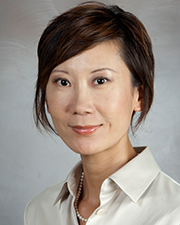Novel research on neural stem/progenitor cells in adult spinal cord published in Cell Reports

Research from the lab of Jiaqian Wu, PhD, professor in the Vivian L. Smith Department of Neurosurgery and the Institute of Molecular Medicine, identifying new subpopulations of cells that could be leveraged to promote regeneration following spinal cord injury has been published in Cell Reports.
Contributing authors for the paper, titled “Glial progenitor heterogeneity and key regulators revealed by single-cell RNA sequencing provide insight into regeneration in spinal cord injury,” include Haichao Wei, PhD; Xizi Wu, MD; Joseph Withrow, MD; Juan Herrera, PhD; Philip Horner, PhD; and Wu.
Previously, the Wu lab purified astrocyte lineage of cells as a pool and studied their overall gene expression using RNA sequencing technology to understand astrocytes’ role in spinal cord injury and recovery. However, as the technology continues to develop rapidly, so does the ability to further delineate the components of this pool and investigate cell subtypes that are previously undiscovered.
Because the adult spinal cord is not regenerative, patients suffering from spinal cord injury often have very minimal recovery after their injuries. Unlike conditions such as stroke, where some degree of spontaneous recovery exist in the brain, there are currently no good therapeutics to recover from spinal cord damage.
Using fluorescence-based cell sorting, the lab gathered cells from animal models with spinal cord injury to sort out glial fibrillary acidic protein (GFAP) positive cells. While analyzing these cells, Wu and her team discovered previously uncharacterized subpopulations of neural stem cells or progenitor cells with a combination of molecular markers and verified their locations and morphologies using quantitative experimentations.
“During an early stage of brain development, there is a type of cell that expresses both astrocyte and oligodendrocyte markers,” Wu said. “We actually found very similar cells, with both these markers in the adult spinal cord, and we call them intermediate cells.”
This discovery gives hope that these cells could possibly give rise to new cells after damage or trauma.
“We were pleasantly surprised we found this intermediate cell population and another cell population called astrocyte-ependymal cells,” Wu said. “This population of cells expresses both astrocyte and ependymal cell markers.”
Previous studies have led to the belief that there are only ependymal cells around the central canal in the adult spinal cord, however in their research, the astrocyte-ependymal cells discovered by the lab also presented in the parenchyma outside of the central canal, with more existing in the white matter of the spinal cord before the injury. Interestingly, their analyses and experiments uncovered an astrocyte-ependymal-Nestin (Nes) high subpopulation with neural stem cell (radial-glia-like) morphologies.
When spinal cord injury occurs, the intermediate cells and astrocyte-ependymal cells proliferate, but they are inhibited by other factors and repressive signals in the injured tissue environment accompanied by inflammation that limit how well regeneration occurs.
“These findings are important because we found the uncharacterized subpopulations of cells. These subpopulations have distinct functional enrichment, and their identities are defined by specific regulators called transcription factors. In the future, we can leverage and look into to promote regeneration in the adult spinal cord through manipulating these resident cell types”. Wu said. “ And continued investigation of the signaling pathways that inhibit endogenous neurogenesis in the adult spinal cord could also lead to strategies to augment regeneration and assist in the repair of the damaged area.”